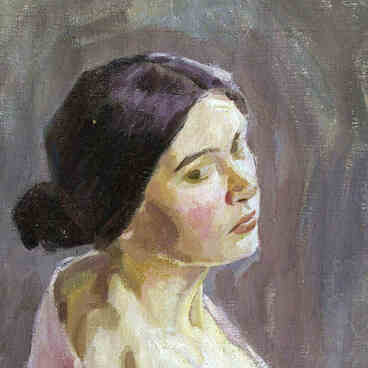The photograph, located on the conductor Golovanov’s desk, perfectly renders the former ambiance of the apartment. This image provides a view of the way Nikolai Semyonovich Golovanov arranged the paintings on the walls of his apartment. Such an arrangement, when paintings hang tightly together, is called Salon-style.
The collection of the famous musician includes paintings by Isaak Levitan, Mikhail Nesterov, and Konstantin Korovin, as well as numerous sculptural portraits, antique furniture in the Empire style, and stucco moldings. At the same time, Golovanov’s presence is everywhere. The very layout of his apartment has a theatrical touch to it: the arrangement of the living room and the office is much like that of a theater auditorium and a stage. The effect of being in a theater is also emphasized with bronze onlays, which are found on many pieces of furniture. Ever since adolescence, Golovanov paid attention to coloring, whether in the visual arts or music with its rich “picturesque” potential. Over the years, he became an avid collector of art. Golovanov started his collection already back in the mid-1910s. As time went on, it was steadily becoming larger. In total, it comprised about a thousand works, of which two-thirds were icons and works by Russian artists. When the conductor was alive, his five-room apartment was literally filled with works of art, as evidenced by the picture where the musician poses for a photographer in his residence.
The valuable information about Golovanov’s collection was provided by the conductor himself, who by the late years of his life had compiled a catalog of Russian and foreign art. Judging by the document and the inscriptions on the paintings, Golovanov sometimes bought the works from the artists and inheritors directly (for example, from Mikhail Nesterov and Viktor Vasnetsov). Occasionally, he bought or received the works as gifts from his colleagues and acquaintances (the conductor Sergei Koussevitzky and the ballerina Yekaterina Geltzer). However, most often he acquired them at exhibitions, in art and antique shops, and through intermediaries.
Sadly, after Golovanov’s death, the collection began to fall apart. When the Nikolai Golovanov Museum was being established, a significant part of the collection was donated to the Tretyakov Gallery and the Vuchetich All-Union Industrial Art Combine. The combine distributed works to various art museums and schools. Presently, the Nikolai Golovanov Apartment Museum has retained only a small part of the collection — 236 works, including paintings, graphic works, and icons. Moreover, the Salon-style arrangement of the paintings was abandoned so that the exhibits would be better preserved.
The collection of the famous musician includes paintings by Isaak Levitan, Mikhail Nesterov, and Konstantin Korovin, as well as numerous sculptural portraits, antique furniture in the Empire style, and stucco moldings. At the same time, Golovanov’s presence is everywhere. The very layout of his apartment has a theatrical touch to it: the arrangement of the living room and the office is much like that of a theater auditorium and a stage. The effect of being in a theater is also emphasized with bronze onlays, which are found on many pieces of furniture. Ever since adolescence, Golovanov paid attention to coloring, whether in the visual arts or music with its rich “picturesque” potential. Over the years, he became an avid collector of art. Golovanov started his collection already back in the mid-1910s. As time went on, it was steadily becoming larger. In total, it comprised about a thousand works, of which two-thirds were icons and works by Russian artists. When the conductor was alive, his five-room apartment was literally filled with works of art, as evidenced by the picture where the musician poses for a photographer in his residence.
The valuable information about Golovanov’s collection was provided by the conductor himself, who by the late years of his life had compiled a catalog of Russian and foreign art. Judging by the document and the inscriptions on the paintings, Golovanov sometimes bought the works from the artists and inheritors directly (for example, from Mikhail Nesterov and Viktor Vasnetsov). Occasionally, he bought or received the works as gifts from his colleagues and acquaintances (the conductor Sergei Koussevitzky and the ballerina Yekaterina Geltzer). However, most often he acquired them at exhibitions, in art and antique shops, and through intermediaries.
Sadly, after Golovanov’s death, the collection began to fall apart. When the Nikolai Golovanov Museum was being established, a significant part of the collection was donated to the Tretyakov Gallery and the Vuchetich All-Union Industrial Art Combine. The combine distributed works to various art museums and schools. Presently, the Nikolai Golovanov Apartment Museum has retained only a small part of the collection — 236 works, including paintings, graphic works, and icons. Moreover, the Salon-style arrangement of the paintings was abandoned so that the exhibits would be better preserved.



